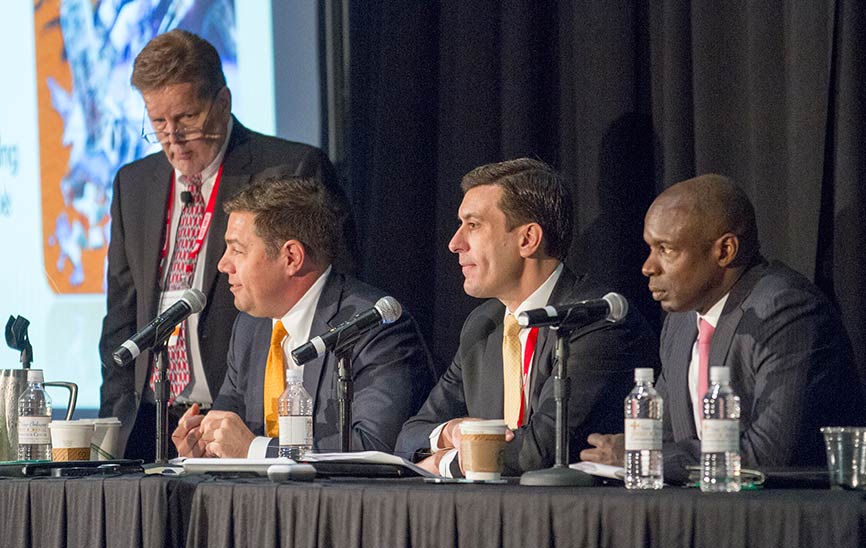
Pictured above, from left, moderator Craig Lekutis of Wireless Estimator; Clayton Funk, Media Venture Partners; Christopher Fisher, Cuddy & Feder LLP; and Robert Paige, Vertical Bridge. (Photo courtesy: Don Bishop, AGL Media Group)
As three leading industry experts gazed into their crystal balls Tuesday during their NATE UNITE 2016 presentation, “The Future of the Wireless Industry,” their consensus indicated a robust build program that could last for more than a decade.
However, Clayton Funk of Media Venture Partners, Christopher Fisher, Cuddy & Feder LLP; and Robert Paige, Vertical Bridge, cautioned National Association of Tower Erectors members that the industry can turn on a dime and their projections – mostly all capital expense driven – could result in a cyclical work flow as it has in years past.
Whether the industry had enough tower crews to safely handle the ambitious deadline for implementation following the FCC’s upcoming incentive auction of TV broadcasters’ 600 MHz spectrum, was a concern to panelists and an audience member, Jack Boone of Broadcast Tower Technologies, Inc., who said that his research indicated that there were more available crews than previous studies have shown.
The smaller number of NATE members who have the expertise and equipment to work on tall towers was evident during the session when only three of the approximately 300 attendees indicated that their companies could work on those structures.
Also of interest was the number of NATE companies that work on distributed antenna systems and small cells. Only three attendees said their business performed those services.
The full session can be viewed on the RCR Wireless video below.
A number of key insights made during the standing room only session included:
- There was general optimism that AT&T would increase its spending in 2016 and 2017 based upon multiple reasons, one being that their new capacity builds, although marginal in 2015, would be about 40% higher. T-Mobile work and lease-ups appear to have increased during the past 90 days.
- Tower acquisition multiples are coming down as indicated by recent sales.
- It was seen as “fairly logical” that T-Mobile and Sprint will merge. Although viewed as a negative to contractors – other than those doing decommissioning work – it would strengthen the industry with three strongly capitalized players.
- U.S. Cellular’s approximately 4,000 towers would be the next major acquisition of any scale if the carrier decided to sell its assets.
- Capital is available to the industry to expand. The amount was seen as “mind boggling”.
- 5G work may not become a reality until 2019, perhaps 2020.
- Work for FirstNet, the public safety network, will continue to be a boon to the industry once the project begins, which could be in a couple of years. Although panelists said the majority of the build would most likely be two antennas and lines per site, they could not identify how many that would be. However, a number times they said it would be “a lot”.
















